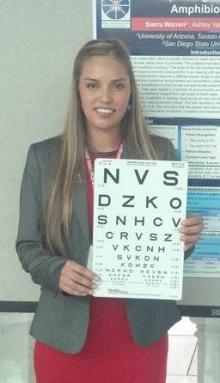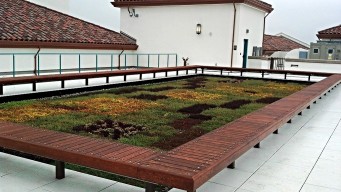San Diego State biochemistry major Sierra Warren was more or less born a fish. She’s been swimming since she was little. Here at SDSU, she played water polo and competed on the diving and swim teams. She moves effortlessly through the water and feels completely at home under the sea, so it always bothered her that whenever she visited the watery depths, she never could see very clearly.
The naked eye provides hopelessly blurry vision underwater, and goggles and diving masks are uncomfortable and frequently fog up. Warren thought there had to be a better solution to seeing underwater.
She sought out the expertise of University of Arizona optical scientist Jim Schwiegerling and dove into optics literature at that university’s College of Optical Science library. Slowly, Warren, Schwiegerling and a few other colleagues began working on a prototype contact lens that would give its wearer the underwater vision of a frog or fish.
Reading or swimming
Warren spent all day studying optics literature, all night testing out the prototype in a university pool. The design for the lens is fairly straightforward: A rigid contact lens is built with a little bubble protruding out the front. Inside this bubble, the researchers squirt a few drops of saline solution. Once the wearer—in this case, Warren herself—inserts the lens, the saline solution covers the eye’s pupil.
Underwater, the bubble full of saline solution refocuses light toward the cornea, counteracting the light’s refraction in the water. The result is near-perfect underwater vision.
Warren was one of 580 students presenting at last week’s SDSU Student Research Symposium, where she explained the lenses’ design and the experiments used to test them.
Vision quest
Colleagues assessed Warren’s vision with the contacts by conducting tests while she was submerged in the pool. They used three different charts: one with letters just like you’d see in an optometrist’s office; another with various shapes; and a third with hand signals.
Warren, who naturally possesses 20/16 vision above ground, had 20/20 vision wearing the contacts in both sunny and artificially illuminated conditions. At sunset with no artificial lighting, her vision clocked in at 20/63. That slight drop-off is to be expected in low-light conditions, Warren said, but it’s still pretty good.
The lenses are surprisingly comfortable, she added.
“At first, they’re a little tricky to put in, but once they’re in, I can barely feel them,” Warren said.
For those of us, like your Curious Aztec, blessed with less than perfect natural vision, the lenses will still work, Warren explained. By varying the shape and volume of the saline bubble on the front of the lens, researchers can make the lens work like a traditional corrective lens, bringing the wearer’s vision to around the 20/20 range.
“It doesn’t matter if you’re legally blind, we can make you see underwater,” Warren said.
Military use
Don’t expect these lenses to hit consumer shelves anytime soon, though. Because of the contact’s rigidity, there’s a danger that it could scratch the wearer’s cornea and invite infection. Instead, Warren and her colleagues think the lenses are more suited to military applications. Specifically, they’d like to see Navy SEAL divers use them to enhance vision during underwater missions.
But eventually, with enough testing and safety measures implemented, Warren’s lenses could become as commonplace as goggles among the general public.
“I love being underwater. It’s where I belong,” she said. “I want everyone to be able to experience the underwater world.”






